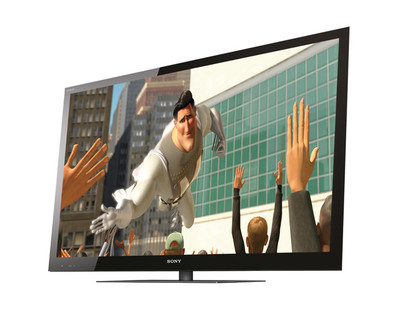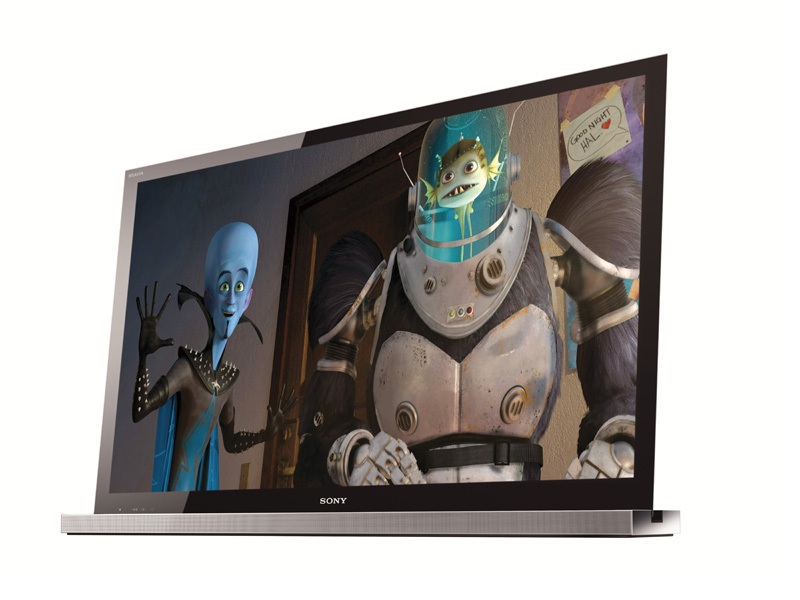Why you can trust TechRadar

Sony's new OptiContrast panel has a clear surface layer that reduces reflectivity and also helps this achieve its claimed contrast ratio of 33,000:1. The screen is noticeably less glossy than previous Sony sets so there are less distracting reflections of yourself sitting on the sofa. The main advantage though is the improvement in contrast that goes with that.
The black levels are deep and solid and the whites are particularly bright with the help of the LED backlight. The contrast level in between is strong enough to ensure detail remains visible even during the dark scenes. Using Coraline on 3D Blu-ray in 2D mode to begin with provides a good test of this as most of the film is set at night. While some TVs struggle to resolve the black figures against a black background, the image here is almost always distinct.
Switch into 3D mode and it's a slightly different story. There's a significant drop in brightness when viewing though the 3D glasses, which makes it trickier to decipher the very dark scenes. Having said that, the brightness hit occurs in all 3D TVs due to the flicker of the glasses and it's actually less pronounced here.
The other advantage this set has in terms of 3D playback is a rapid frequency response that prevents the dreaded crosstalk from ruining the effect. This is when echoes of the left and right images linger and overlap slightly to create a shadow and shatter the image. There are traces of crosstalk here, but that's all.
There's also a perceived drop in resolution when you don the glasses, too. The alternating left and right images leave you seeing a slightly softer version of the image even though each eye is actually seeing a 1080p image. Again, it's a feature of frame sequential 3D, and this set is no more prone to it than any other.
In fact, what you see here is a fairly convincing 3D image that stretches well back behind the screen, while objects in the foreground loom plausibly into the room. The bold colours, crisp detail and speedy processing all conspire to paint a particularly lifelike 3D picture.
This set can also convert 2D into 3D with the push of a button - if you really want to. This mode adds some ,impression of depth, but it's not very realistic and of course, introduces all the negative aspects of 3D, like the drop in brightness and sharpness, so really it's a sure way to ruin a good film.
Sign up for breaking news, reviews, opinion, top tech deals, and more.
Switching from Blu-ray to the TV's own Freeview HD tuner is a refreshing surprise. LCD panels of this size are usually very unforgiving of compressed standard-def material, but Sony's Bravia Engine 3 processing is clearly doing a decent job of tidying up the image in terms of clarity, contrast and colour fidelity.
What you won't see here is any dreadful artificial sharpening of the image. All too often, TV manufacturers use video processing to attempt to make images appear smoother and less grainy and end up with glitchy and artificial results. Motionflow 200Hz Pro is the latest version of Sony's frame creation processor that uses backlight blinking to deliver four times the number of frames as a 50Hz set and a stable, non-jerky image. This it manages to do without creating a halo around fast moving objects. The important point is that you don't notice it and the picture always looks natural.
Current page: Sony KDL-55NX813: Picture
Prev Page Sony KDL-55NX813: Features Next Page Sony KDL-55NX813: Sound, value and ease of use
Jim has been evaluating printers for more than twenty years and has, to date, written over a hundred reviews for TechRadar Pro. From pocket printers to industrial dye sublimation, Jim has been there, run the tests and printed the t-shirt. His expertise extends to consumables (paper, ink, toner) and his printer buying guides make it easy to compare these essential peripherals.
